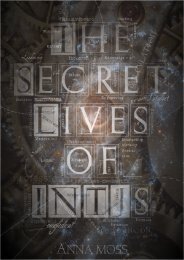You also want an ePaper? Increase the reach of your titles
YUMPU automatically turns print PDFs into web optimized ePapers that Google loves.
Rationals seldom confuse the means with the ends. For them, life is like a series of nesting<br />
parentheses in which x is solved so that y can be solved so that z can be solved. Newton bought an<br />
astrology book (astronomy and astrology were more closely related in those days than now), but<br />
found that he couldn't read it because he didn't understand the trigonometry involved. So then he<br />
got a trigonometry book and began reading that, only to find that he couldn't understand the<br />
demonstrations. So then he bought a book by Euclid so that he could understand the<br />
demonstrations. He then read just the specific sections of Euclid that he needed to understand the<br />
demonstrations. 210 In each step of the chain, Newton focused tightly on the results that were<br />
necessary to achieve the end goal; the rest was chaff and he discarded it.<br />
Within the context of school, the supposed goal is to learn, but this learning does not solve any<br />
particular problem as framed within an NT perspective. The real goal of school is to get a degree<br />
and employment. Newton achieved this goal with the minimum effort required, then spent the rest<br />
of his time on his own goals.<br />
Many a student has dreamed that some kind of emergency would happen so that they could get out<br />
of school. Seldom have such fantasies been answered so thoroughly as in Newton's case: the black<br />
plague struck in 1665 and the college had to be completely evacuated. He went back home to his<br />
mother's estate in the country and stayed there for two years. 211 It was during this period, where<br />
Newton was free of responsibilities and had plenty of time on his hands, that he made the<br />
discoveries for which he is remembered.<br />
Scientific Achievements<br />
Have you ever wondered how mad scientists can make extraordinary breakthroughs in science, yet<br />
then keep the secret to themselves for years on end? (Of course, they will tell meddling do-gooders<br />
whom they capture all about it, but that's not really the same, is it? On a side note, Keirsey suggests<br />
that Rationals love to explain their projects to those who will listen. Literally, monologuing.) But<br />
there is truth to the stereotype, because INTs are very good at keeping information to themselves,<br />
especially personal information. They are the black body of types.<br />
During his plague-inspired exile, Newton figured out calculus, the theory of gravity, and centifugal<br />
force. 212 Between the latter two ideas, he began to understand the dynamics of the solar system.<br />
But he told no one, and kept the ideas to himself for decades.<br />
Newton's first glimmer of scientific recognition came from a completely different source. He built<br />
one of the first reflecting telescopes, this being a leap and a bound above the existing models. The<br />
achievement is interesting mainly because it highlights how useful the INTJ's meticulous, precise,<br />
exact approach to life can be in the pursuit of science. It was very difficult to produce a working<br />
reflecting telescope because the instrument required exceedingly fine craftsmanship. Scientists had<br />
been trying for years; White (1997) gives the account of another mathematician who had hired<br />
“some of the best craftsman in the country” for the task without success. Newton's telescope was<br />
unique because it actually worked well.<br />
The way he accomplished this was through unmatched accuracy. He had to cast, grind, and polish<br />
his own mirror, a task which he accomplished with tools he made himself. 213 To get the mirror<br />
right, he made measurements of hundredths of an inch using only compass and eyeball. This was<br />
210 White, 1997<br />
211 Levenson, 2009<br />
212 And perhaps also the properties of light, i.e. the formation of colors, but this is less certain.<br />
213 White, 1997




